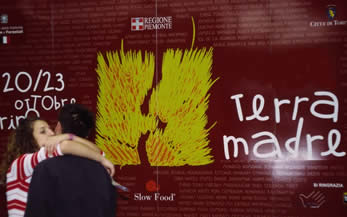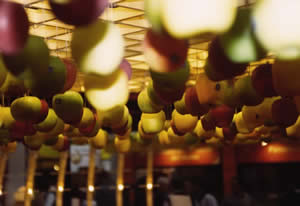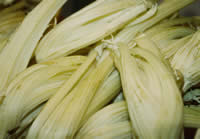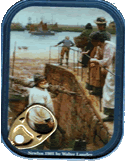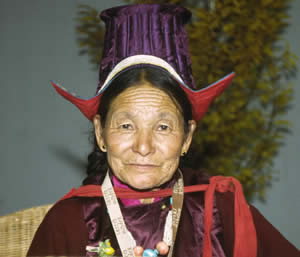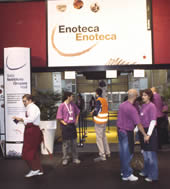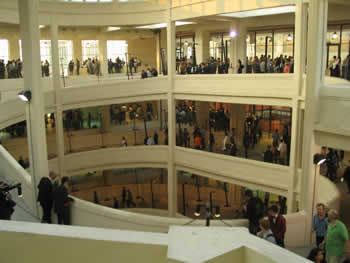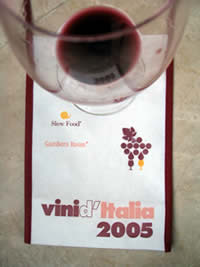
Salone del Gusto and Terra Madre 2004
Turin, Italy October 21-25, 2004 Imagine the whole world (or nearly) coming together to break bread, share food, wine and culture (metaphorically and literally) all under the vast single roof of Lingotto Fiere in Turin, Italy. This is the Salone del Gusto, a biennial event staged for the fifth time in 2004 from October 21-25. The aim is to bring together artisan producers and so provide a showcase for traditional foods from Italy and further afield. As such, it gives us all — trade, press, and consumers alike — the opportunity literally to taste the world.
On one level, the Salone del Gusto is a vast exhibition with pavilions where exhibitors set up their wares rather like an immense village market or food festival, with lanes dedicated to specific themes, grains, oils, cheeses, whatever. Not surprisingly given the Italo-centric view of not just the world but of gastronomy, the Buon Paese market featuring Italian products is by far the most important. However, there is also an increasingly significant international presence here, too, gathered together under the banner of Mercato del Mondo or World Market. I was pleased, for example, to see from our own home region, South West England, exhibitions for Plymouth Gin, Cornish pilchards, and Quicke’s farmhouse cheddar alongside stands for Japanese sushi, jamón Iberico from Spain, Polish pasta (talk about taking coals to Newcastle!), aged Gouda cheese from the Netherlands, smoked wild Irish salmon, and much more.
The Trentino Alto-Adige regional pavilion offered tutored food and wine tastings at regular intervals throughout the show
This is a food show, of course, and selling and commerce takes place, but the Salone del Gusto is in spirit and ethos far more than simply either a trade or consumer exhibition. Since it aims to promote and encourage above all traditional and artisan foods, an equally important and fundamental focus of the event is to inform and educate, both by providing information as well as actual opportunities to taste. Indeed, because many of the people taking part are involved in artisan and traditional food production, in many cases making products or cultivating produce that without such recognition might be at risk of dying out, they are eager and enthusiastic to share with you what they do, rather than simply to try and sell you their wares.
There is furthermore an ambitious programme of Taste Workshops and Seminars that take place on any number of subjects throughout the days and evenings of the Salone, while there are also demonstrations from top chefs in the Theatre of Taste, Regional Pavilions, and Dinner Date events in scores of restaurants throughout the surrounding Piedmont countryside.
Slow Food Presidia
The nominated Slow Food Presidia are among the most fascinating and interesting elements of the Salone. Each Presidium represents a project that aims to protect and promote a noteworthy specific food product with exceptional taste qualities that might otherwise be under risk, and which furthermore represents something of the culture of an entire community. In 2004 there were around 190 such designated Presidia and the producers were encouraged to take part in the Salone with financial support to enable them to attend.
Italian Presidia are the most prevalent and represent a vast variety of foods and produce: (from Sicily) Ciaculli mandarins, grown in the fertile Palermo citrus groves and gardens; (from Calabria) an outstanding traditional Moscato wine vinified in Saracena by allowing grapes to vine dry then mixing with cooked grape must; (from Campania) the famously fragrant Amalfi lemon and the prized San Marzano tomato; (from Emilia-Romagna) the rare and prized culatello di Zibello, sweetest and most fragrant of all cured hams as well as the traditional mortadella classica di Bologna, each mortadella an enormous, handcrafted work of art, to be cut by hand, beautifully fragrant and delicious.
It is fascinating to stop at the various stalls and learn about and taste these produce and products, each with their own story. Take for example the cardi gobbo of Nizza Monferrato. Cardoons, a type of edible thistle, may not generally seem anything to write home or books about, but this variety is particulary prized and delicious, and is the result not just of nature but of man’s ingenuity. For the cardi are first cultivated and, once grown, they are then ingeniously tied together in a bunch, bent over and buried to enable growth to continue underground (‘gobbo’ means hunchback since the thistles are bent back on themselves). This results in a white vegetable that is particularly tender and not bitter, excellent either raw to dip into bagna caôda (the favourite pungent anchovy dip of the region), or else cooked. This procedure is apparently carried out only in around the Monferrato hills of Nizza, south of Turin, and nowhere else. As it is incredibly labour intensive, the granting of Presidia status recognises and gives value and encouragement to the growers of the zone.
Cardi gobbo di Nizza Monferrato — protected and recognised by
Slow Food Presidium status
In addition to Italian, there are also international Presidia from all over the world, granted to any number of unique products or produce that are at once noteworthy and deserving of both greater recognition as well as protection. From Britain, there are Presidia for traditional artisan made farmhouse cheddar cheese; farmhouse perry (an alcoholic beverage made from pears) from Hereford; and salted Cornish pilchards which have long found a market in Northern Italy as part of the everyday diet of working people, salacche e polenta. Grains from all over the world are protected and promoted with Presidium status, including Mexican armaranth, Andean maize, Canadian Red Fife wheat, and red rice from Madagascar. Cheese made from raw milk by traditional methods is another important theme that is recognised, with Presidia for yak cheeses made at 4500m altitude on the high Tibetian plateau, as well as raw milk cheeses from the United States, Great Britain, Ireland, France and elsewhere. The husbandry of native breeds, meanwhile, is also recognised: meat and cheese made from Gloucester cattle; the indigenous Basque Euskal Txerria breed of pig; reindeer from Sweden.
Cornish pilchards — salacche di Cornovaglia
The stands that represent the Presidia of Slow Food aren’t only here for people to come and make purchases (in some cases it is not even possible to purchase); above all they are representatives of the Slow Food philosphy that seeks to champion biodiversity and the protection of not just foods, but of a local culture and entire ways of life.
Terra Madre
This year’s theme for the Salone del Gusto was Food Communities, and in conjunction with the simultaneous Terra Madre project taking place in the nearby Palazzo di Lavoro, the events were indeed a joint celebration and reaffirmation of the food producers and communities of producers. Indeed Terra Madre brought together individuals from all over the world involved in every phase of food production including farmers, cheesemakers, butchers, fishermen, beekeepers, winemakers, bakers, chefs, cooperative agronomists, nomadic herdsmen and women, and many more, all coming together share problems and solutions, food and friendship.
The sheer logistics of this vast and ambitious undertaking were mind-boggling for Terra Madre gathered together over 4000 delegates from some 130 countries grouped together in 1200 food communities from five continents. Delegates were put up in private homes, monasteries, agriturismo guesthouses and bed & breakfasts throughout the region, and a strong element of the event was about creating bonds and common links between differing cultures. Each day an extensive programme of talks and seminars and workshops took place in the Palazzo di Lavoro over the most fascinating ranges of topics, from the transhumance to common problems in the raising of livestock to making cheeses from raw milk to the economics of female cooperatives and associations in the developing world.
A Terra Madre delegate from the highlands of Ladakh
Meanwhile, the Palazzo di Lavoro itself was transformed into a true global village as delegates sprawled out on the floor, many in their national dress, spoke to visitors and new aquaintances in whatever common language we could find, while sometimes offering foods and handicrafts for sale. I met some people from Ladakh who were eager to explain to me about the dried pellets of spinach-like vegetable they eat along with mountain herbs from the high arid Himalyan plateau. I encountered a campesino from Peru and learned about arracacha, an indigenous tuber cultivated organically in the Andes. I tasted sun-dried mangoes prepared and sold by a women’s cooperative in Burkina Faso. And over lunch I enjoyed a lively and fascinating discussion with a proud and handsome native Canadian from Vancouver Island who supplements traditional salmon fishing with the sustainable gathering of herring spawn on kelp, a product that finds a ready market in Japan.
Wandering through this vast collection of humanity, bound together with the common interest in learning more about how we all live and eat and survive and prosper, sharing and interweaving the stories of our cultures and civilisations, was indeed a humbling and inspiring experience.
Food and wine writer and author Carla Capalbo wearing a most splendid hat she acquired from a pescivendola — fishwife — from Equatorial GuineaSlow Wine at the Salone del Gusto
Slow Food as a movement has long been a champion of ‘slow wine’, that is, wines made from indigenous grape varieties using traditional methods, wines that are hand crafted artisan works of art, not mass or industrially produced. At the Salone this year, there was certainly plenty of opportunity to taste wines as well as foods. For example a vast Enoteca offered visitors the chance to taste wines from throughout the world and every region of Italy, while the Sala di Nebbiolo had on show Nebbiolo wines made anywhere in Italy or the world that this rare and prestigious grape variety is cultivated.
The Salone Enoteca offered visitors the chance to taste wines from throughout Italy and the world
Numerous Taste Workshops explored wines (horizontal tastings of Chateauneuf-du-Pape, Barolo and Brunello di Montalcino; vertical tastings of Chateau Rauzan-Ségla and Dom Perignon; an introduction to the wines of New Zealand; organic wines from the United States) as well as investigated relationships between wines and foods (parmigiano reggiano and great Tuscan reds; Comté and Chateauneuf-du-Pape; mortadella and sparkling wines).
The Tre Bicchieri Gambero Rosso tasting of wines takes place on the famous Fiat ramps of Lingotto that lead to the test racetrack on the roof
The most important wine event at the Salone is the Tre Bicchiere Gambero Rosso/Slow Food guide awards, and afterwards the remarkable tasting set up on the four-story Fiat ramps that lead to the amazing test racetrack on the roof of Lingotto. The annual guidebook ‘I Vini d’Italia’ co-published by Gambero Rosso in conjunction with Slow Food is considered by producer and public alike to be the most important eagerly awaited annual Italian wine publication. Wines that are awarded the highest accolade, elite ‘Tre Bicchieri’ (three glasses) status are virtually guaranteed the fast-track to commercial and popular success.
So the Tre Bicchiere tasting itself is something of a celebration for the entire Italian wine industry as well as for the individual producers whose wines have been so awarded. Every single wine on display - some 260 - is either a legend or a newly born legend (for this select status is like winning the Oscars of the Italian wine world): the great Barbareschi and Baroli of Angelo Gaja, Ceretto, Conterno and other maestri from the Langhe; such usually untouchable and near unobtainable legendary wines as Sassicaia, Ornellaia, Guado al Tasso, Massetto and Redigaffe from Bolgheri and the Tuscan seaboard; the best, most prestigious sparkling wines from Franciacorta and elsewhere; super-Tuscans galore, sleekly modern with their polish of new French barrique; great, concentrated white wines from Friuli and Trentino-Alto Adige; astonishingly brilliant new wines from ancient grape varieties grown in Italy’s deep south, Campania, Basilicata and Puglia; and traditional as well as new-wave wines from Sicily.
Where to begin? On arrival at the hall, I was given a very large tasting glass and a glass holder to wear around my neck. I went up to the top floor, reasoning that it would be far easier to make may way down the ramps than to struggle up them after a glass or two too many. And I began to taste, starting first with those mythical wines from Bolgheri...and wandering serendiptously on an extended and most happy journey through Italy in a wine glass.
For lovers of Italian wines, the Tre Bicchieri event presents an unrivalled opportunity to encounter and sample such incredible vinous riches in a single tasting. As such, it is wholly conceived in keeping with the essential Slow Food ethos and philosophy.
This is a philosophy that above all celebrates the excellent, the individual, the artisan; it celebrates biodiveristy and glorious variety in a world that elsewhere seems to be becoming ever more homogenous; it is a philosophy that recognises and extols our common humanity, not our differences, and which encourages us all to take time out simply to enjoy...slowly.
Salone del Gusto
What? A unique exhibition with a host of Italian and international exhibitors offering a vast range of outstanding products that are virtual symbols of local, regional and national cultures. In addition to exhibitors, there is an extensive programme of Taste Workshops, plus the Theatre of Taste and Dinner Dates across the region.
Who? Organised and inspired by the Slow Food movement with assistance from the Regione di Piemonte authorities, as well as commercial sponsors. Producers come from all over Italy and the world and there are top chefs and VIPs who are increasingly involved.
When? Takes place every two years. Next Salone del Gusto will be October 2006.
Where? Lingotto Fiere, Turin, Italy
What is Slow Food? An international movement that started in Italy, born out of desire to protect and maintain traditional and artisan foods and ways of eating and living.
Find out more: www.salonedelgusto.com and www.slowfood.comCopyright © Marc Millon 2004
Photographs copyright © Marc Millon 2004 All rights reservedContact Marc Millon
![]()
|Home| |QP New Media| |Kim's Gallery|
Copyright © Marc and Kim Millon 2004
![]()

